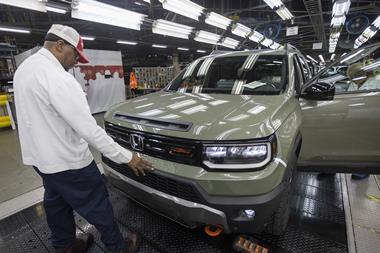
With high-tensile strength and an optimised microstructure, advanced high-strength steel grades can offer many advantages for chassis components
Many factors are dictating the future of OEMs developing chassis components. Consumer trends, regulations and advancements in manufacturing technology are just a few of them. Developments in materials is another. With the help of some industry experts, we explore the future of chassis – and ask if traditional materials like steel can still be a viable choice.
When asked what the future holds for the development of chassis, one principle design engineer of a major automotive OEM says: “When it comes to the actual design of chassis, I’m not really sure that things will change so much. The systems we have today were found in cars 30-40 years ago. They are a bit more refined, yes, but basically the same as before. However, the big change, one that is already happening, is in materials.”
Chassis components are challenging to make. They often have to be stiff, while accounting for moving parts. They must also have a long fatigue lifetime – all in a tight package. Therefore, materials with a high strength to weight ratio are preferred.
With the lightweight era upon us and a strong focus on electric vehicles, with their extremely heavy batteries, the need for strong and lightweight materials is greater than ever.
Many people associate the traits of lightweighting, strength, ease-of-form and good hole expansion with materials like aluminium, casted light alloys, carbon fibres and other materials – especially when it comes to chassis components. However, while these materials are receiving a lot more attention in recent years, many are finding that developments in steel, especially hot-rolled advanced high-strength steel (AHSS), are allowing them to achieve the desired results in chassis components at a lower cost. And this trend is expected to continue.
AHSS still delivers performance
Looking closer at AHSS, it can be seen to offer many advantages in chassis components. Young’s model is high for steel, and in combination with good formability, it is possible to reach high stiffness in components. High tensile strength and an optimised microstructure also give excellent fatigue properties.
Hot-rolled steels also have good forming properties. Strength levels up to 1200 MPa are available, which is four times higher than high-strength aluminium, and steel is also the most cost-efficient lightweight material. Overall, the complexity and high integration level that chassis require today can still be solved with steel.
Chassis components often have design properties that are in the range where hot-rolled steel is more suitable than cold-rolled steel. One of the biggest reasons for this is thickness. Cold-rolled steels are generally only available with low thicknesses, whereas hot-rolled steel products go beyond, from 2.0 up to 6.0 mm.
“In addition to a wide thickness range, hot-rolled AHSS makes it possible to drastically increase the tensile strength in a component, while reducing the amount of material needed to produce it. This can result in a significant reduction in weight, while achieving the same performance and a lower cost, thanks to less material needed overall,” explains SSAB’s Daniel Sund.
Hot-rolled offerings
SSAB introduced a range of hot-rolled AHSS grades to its Docol product portfolio of automotive steels. At the centre of this new focus are chassis components.
In 2011, SSAB invested in a new cooling line for its hot-rolling mill, resulting in the ability to create many more grades of hot-rolled AHSS, with high consistency.
“The cooling line gives us both cooling power and the accuracy to hit the exact properties that we wish. As a result, SSAB can produce a wide range of steels with tailored performance. Many years of adjusting and improving our hot-rolled processes have led to this,” explains Sund.
Many more grades are currently in development, including steels like complex phase, martensitic steel and press-hardening steels, as well as grades with improved hole expansion and the new 3rd Generation steels. Each can provide characteristics that are interesting for chassis applications.
“In recent years, the hunt for better formability has taken a turn towards better hole expansion in AHSS with current strength levels,” says SSAB R&D specialist Erik Nymann.
“As a result, there are many new possibilities for choosing strong hot-rolled AHSS that allow for this. Development that will undoubtedly be useful in the future as new chassis specific grades are developed.” With AHSS, chassis component manufacturers will find innovative design and process solutions that will allow for achieving improved properties such as weight savings, improved performance and reductions in costs.
The 3rd Generation
Despite its extremely long history and somewhat understated reputation, steel is a material that has continually undergone development, and it is not done yet. So-called 3rd Generation AHSS is a great example. This new term and the grades of steel that will be classified under it are increasingly being called ‘the future material’ of the automotive industry and chassis components.
These steels, which are still early in development, secure a substantial part of residual austenite that is transformed to martensite during forming. For instance, QP and Medium Mn-steels are considered 3rd Generation AHSS.3rd Generation AHSS will be developed in order to offer an attractive combination of strength, ductility and usability. Usability refers to everything from formability, weldability, corrosion resistance and hydrogen resistance to robustness and uniformity.
In addition, 3rd Generation AHSS is being developed to be cold-formable, making it useable with conventional equipment, more cost-effective and easy to produce. They could be a game changer for automotive OEMs by offering the possibility for even superior strength-to-weight ratios as well as simpler production.
Development status
Currently, 3rd Generation AHSS is still in the early stages of development. “It is important to note that, currently, it is unknown which concepts and grades will end up being the backbone of 3rd Generation AHSS,“ says Joachim Larsson, head of product development at SSAB Europe. “However, as the iterative work between steel mills and automotive OEMs continues to mature, common grades will emerge. There will also be a natural merge between the three generations of advanced high-strength steel as continuous improvements are performed on the existing grades.”
In terms of development, 3rd Generation AHSS is new from an alloying point of view, but also when it comes to temperature cycles. This means that there are still important parts of the ‘design space’ to be investigated, but also modern process technology, which will open up new opportunities. For instance, improved possibilities to hit tight temperature intervals will make revisiting old, yet promising concepts relevant.
The verdict
After thousands of years of iron solutions and hundreds of years with steel, it is still possible to develop new and innovative grades that can be used for chassis components. Steel is by no means an outdated material. On the contrary, it is one that is continually being improved upon.
The reason for this is that there are so many degrees of design parameters to explore. Active alloying elements for steel go far beyond iron and carbon, which opens up countless opportunities. The possibility to design new combinations of deformations, time and temperature in the process also allow for new types of steel to emerge and be optimised. With AHSS, especially hot-rolled, OEMs will find innovative design and process solutions that will allow for improved properties in chassis with weight savings, and lower costs.






































